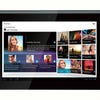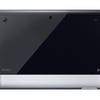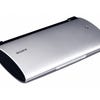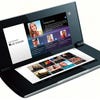Sony Tablet S/Tablet P Review
PlayStation-certified Android tabs, anyone?
In October of last year, Sony announced that it would be buying out mobile partner Ericsson's stake in the joint venture founded by the two companies way back in 2001. Sony Ericsson - a major force in the world of mobile telecommunications - would become plain old Sony.
While the world waits for the first Sony-branded handsets of 2012, it's worth noting that the firm has already started to strike out on its own in other sectors. Last year, around the same time that the Sony's buy-out of Ericsson was broadcast to the world, the Japanese manufacturer was already working on two Android-based tablet devices.
Predictably, these products have tiresomely been labelled 'iPad beaters' by some sectors of the technology press, but from a purely gaming perspective it's the inclusion of the much-hyped PlayStation Suite that catches the eye. So how good are these products and does the PlayStation connection actually offer up any kind of valuable gameplay experience?

Tablet S: Sony's iPad Challenger
Of the two devices, the Tablet S is clearly the more conventional. From the front, the slate-like device looks very much like an iPad, albeit with a 9.4-inch display. The rounded corners only add to the sensation of familiarity, but when you flip the device over, you're presented with a design landscape that is about as far removed from Apple's ethos as you could possibly get.
Viewed from the side, the Tablet S looks like a magazine that has been dropped on a table with its pages open. It's thick at one end, and tapers down at the other, and there's a pleasing round bend at the top of the device. The upshot of this is that when you rest the tablet down on a flat surface, it presents a near-perfect viewing angle, removing the need to crane your head over the screen.
That 1280x800 resolution display deserves a second look, too. Sony's 'TruBlack' TFT LCD tech claims to deliver improved contrast and brightness, and when placed alongside the iPad 2, these bold assurances seem to carry a lot of water. Viewing angles are also first-class, which is vitally important on a device which is constantly moving as you adjust your grip and shift it between hands.
A quick run-through of its other features feels akin to a box-ticking exercise; the Tablet S boasts a dual-core CPU running at 1GHz and backed by 1GB of RAM. There's a rear-facing five megapixel camera for those moments when you feel brave enough to take a shot with a device that positively dwarfs your point-and-shoot digital camera, as well as a front-facing version for video calls via Skype and other services.
Android Aspirations and PlayStation Certification
Both the Tablet S and Tablet P are running Google's Android operation system: more superficially, they're loaded with version 3.2, otherwise known by its codename Honeycomb. Google's first tablet-focused OS, Honeycomb has already been superseded by Android 4.0 (which has been blessed with the even more ridiculous codename Ice Cream Sandwich - Google christens all of its OS iterations after desserts), which is an attempt to unify the handset and tablet branches of Android. Ice Cream Sandwich has already been confirmed for both Sony tablets in 2012, but for the time being, 3.2 remains solid and flexible.
If you've used an iPad before, Android simultaneously seems instantly familiar and uncomfortably different. The same grid-based icon system is in force, and you can use multi-touch 'pinch-to-zoom' gestures on photos and web pages. However, Android grants a much deeper level of user customisation with animated wallpapers, re-sizable live widgets and a more comprehensive barrage of options. What the platform lacks in intuitive design it makes up for in control; if you enjoy tinkering with things until they completely suit your own personal tastes, you'll find a lot to like here.
"The PlayStation Suite currently under-delivers - you only download a frustratingly narrow selection of crusty old 32-bit PlayStation titles for around four quid a pop with titles such as Destruction Derby, Cool Boarders and Jet Moto hardly causing the heart to skip a beat."
The Tablet S packaging proudly displays a 'PlayStation Certified' logo, hinting that the device - along with its sibling, the Tablet P - could be gunning for the same space occupied by the Nintendo 3DS and Sony PlayStation Vita. A recent update for the Tablet S which enables wireless connectivity with PlayStation 3 Dual Shock pads only serves to add credence to this impression.
Unfortunately, the gaming aspirations of the Tablet S are rather more sedate. The PlayStation Suite - which was teased early last year - is distinctly underwhelming. It basically offers the same functionality that the Sony Ericsson Xperia Play's 'PlayStation Pocket' gateway does; namely, you can download a frustratingly narrow selection of crusty old 32-bit original PlayStation titles for around four quid a pop.
The current library is disappointingly limited; Crash Bandicoot comes pre-installed (just as it did on the Xperia Play) and other available titles such as Destruction Derby, Cool Boarders and Jet Moto hardly cause the heart to skip a beat. One would sincerely hope that such slim pickings will improve as time goes on, but the trickle of software available for the Xperia Play has almost completely dried up - which hardly fills you with confidence that the Tablet S and Tablet P will fare any better. Hopefully the PS Vita connection with the PlayStation Suite will bear some fruit but in the here and now it comes across as a woefully poor platform.
In a move that qualifies as an ill-advised poke in the eye for loyal Sony fans, it's impossible to transfer your Xperia Play PlayStation downloads to either the Tablet S or Tablet P. On the Xperia Play, games were downloaded directly through the Android Market, but with these new tablets Sony instead forces users to sign in with their PlayStation Network accounts, where the exact same software must be re-purchased if you want to play it. Clearly, Sony is more comfortable peddling its wares from its own digital storefront, but when you consider that both the Xperia Play and Tablet S run Android, there's no reason - other than profiteering - to prevent existing Play owners from installing their previously-purchased content on their shiny new tablet. To reiterate: the games are exactly the same, it's just the store that they are sold in that has changed.
Introducing the Dual-Screen Tablet P
While the Tablet S manages to tick all of the right boxes when it comes to design, it remains a pretty traditional tablet device. The Tablet P, on the other hand, is the complete opposite. It's the kind of product that is sired by a company that is throwing everything at the wall in the hope that some of it sticks, but lamentably it suffers from a number of crippling flaws.
Taking a leaf out of Nintendo's well-thumbed design book, the Tablet P is a clam-shell device which is only a little larger than the 3DS when closed. Opening it up reveals two 5.5-inch, 1024x480 resolution screens, both of which use the same 'TruBlack' tech seen in the Tablet S. Although there's a gap separating the twin displays, they function as a single screen - for the most part, anyway.
The Tablet P's biggest problem is that Android doesn't play nice with such a display configuration. Apps and games which require a single swipe across both displays are rendered unusable, as the line is broken as soon as your finger crosses that No Man's Land between the two screens. Many apps - including Google's official Android Market - won't even play ball with twin displays, and instead confine themselves to just one. Instead of offering a large-scale tablet experience, the Tablet P often provides something that is only slightly larger than a mobile phone, but with added bulk.
You might assume that thanks to its clam-shell design and almost pocket-sized dimensions, the Tablet P could possibly be rescued by its suitability as a games platform. Sadly, that couldn't be further from the truth. Although it carries the same PlayStation certification as the Tablet S, it's not currently possible to wirelessly connect a Dual Shock pad to the Tablet P. In fact, the tablet we reviewed refused to connect with the pad even over a wired USB connection, which is unusual as this is a standard feature of all Android 3.2 tablets, not just the Sony ones.
Without physical controls, the Tablet P's gaming hopes take a nosedive. The touch-screen virtual buttons are just as indistinct and imprecise as you'd expect and prove to be the worst possible interface for old 32-bit titles originally built around a proper joypad. Gaming performance is eroded further by the fact that the four L and R triggers are located on the top screen, which makes them impossible to touch during play unless you're lucky enough to possess another pair of hands.
The Tablet P is certainly an interesting concept, and stands out from the hordes of iPad wannabes currently clogging up the shelves, but its screen setup means it's always going to struggle when it comes to app compatibility and the prohibitive high cost (£500 at the time of writing) means that you're spending £100 more than the cost of an iPad 2 just to create the unwelcome feeling that you really should have just bought Apple's device in the first place.
The Verdict: Workmanlike Success and Dismal Failure
"The Tablet S is a well-designed and eminently usable challenger, while the Tablet P has some interesting ideas that sadly come unstuck in the final execution."
The Tablet S and Tablet P represent Sony's first forays in the tablet arena and register as a workmanlike success and a dismal failure respectively. The former is a well-designed and eminently usable challenger, while the latter has some interesting ideas that sadly come unstuck in the final execution.
Curiously, given Sony's remarkable clout in the video gaming sector, neither tablet convinces as a gaming device. The PlayStation Certification ends up being little more than an excuse to hawk age-old games that we're already played a countless times over on other platforms - including the Xperia Play mobile phone - and once the allure of Crash Bandicoot has faded, you're left with the standard Android Market to satisfy your gaming urges. While Android's app and game storefront has done an awful lot of catching up in the past twelve months, and apps such as World of Goo look amazing on large displays, there's no denying that the iPad still receives the best development support right now.
As Sony Ericsson slowly re-brands as pure Sony, you'll start to see a flood of new mobile handsets hitting the market in 2012. Given the explosion of interest in tablets, it's fair to assume that Sony will also be launching successors to the S and the P - one can only hope that the company can prevent itself from becoming distracted with clam-shell oddities and instead improve on the likable Tablet S.









